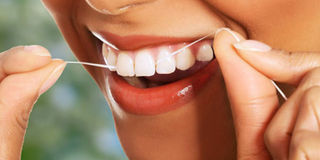Flossing is healthy but can be harmful if done wrongly

“How often do you floss your teeth?” I randomly asked my colleagues while sourcing this story, under the naïve assumption that most have tried it, and perhaps just got lazy. Surprisingly, some have never tried it, even once.
Enid Ndairiho, a public health dental officer, says flossing—the use of a thread to dislodge food particles and plaque from the spaces between teeth—is an essential oral hygiene practice which, alongside brushing, prevents tooth decay, gum disease and bad breath.
Unfortunately, the easier and more common alternative is the toothpick but medics discourage it because not only does it do an incomplete job, it could also damage your gum.
Flossing and brushing, Ndairiho insists, should not be substituted for each other, rather, they complement each other.
How and when to floss
Ndairiho recommends flossing every after a meal but because “our work schedules make this hard, let’s try at least once every day.”
So to remove those unwanted food particles from your interproximal spaces, and around your teeth, “First brush without toothpaste, just plain water, floss, then brush again with toothpaste,” she says.
As you face your mirror before flossing, break off about 45 to 61 centimetres of dental floss, roll most of it around both of your middle fingers. Leave only about three to six centimetres of floss for your teeth.
Hold the floss cord with your thumbs and index fingers.
Place the floss in between two teeth. Gently move the floss up and down, rubbing it against both sides of each tooth, carefully, to avoid damaging your gums.
As the floss reaches your gums, curve it at the base of the tooth to form a C shape. This allows the floss to enter the space between your gums and your tooth, flossing the back side of each tooth as well. Repeat the steps as you move from tooth to tooth, unrolling a fresh, clean section of floss with each tooth.
After flossing, Ndairiho recommends, brush with toothpaste but do not rinse your mouth so that the fluoride and calcium in the paste guards your teeth against germs.
Normally, Ndairiho says, flossing should be done under four minutes and without any side effects.
“However, if it sparks excessive bleeding you need to see a doctor.”
Floss holders, or pre-threaded flossers, are more user friendly, and can also make it easy to train the children with because they can fit in smaller mouths. They are also the best for caregivers who need to floss someone else’s teeth, according to Dr Pamela Li, a cosmetic and general dentist. Using just the string, not the pre-threaded flossers, might make it harder to reach those tricky spots, like the back sides of your wisdom teeth— the four hindmost molars. Even then, Ndairiho says “it’s far better than not flossing at all.”
Cost
One 50-metre pack of dental floss ranges between Shs4,000 to Shs5,500 in different groceries and pharmacies, while a pack of three-in-one pack of 36-metre floss goes for around Shs11,000 and Shs13,000.
A 50-metre pack (equivalent to 5,000 centimetres), can cover you for nearly 90 days, if you floss once every day.
But if you still cannot afford that, Ndairiho recommends a cheaper and more accessible alternative. “You can pull a string from that pack in which you bought your maize flour (kadeeya in Luganda), clean it thoroughly and use it as your floss.”
The exception
“Those people whose teeth are spaced do not need flossing because no food sticks between their teeth,” she says.




